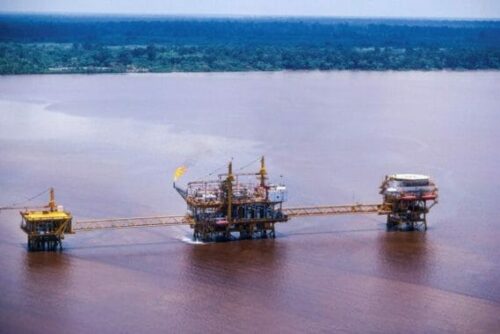Amarinth provides definition for ‘Tropicalisation’ of pumps as user demands increase
FOR IMMEDIATE RELEASE – 23 May 2013

Amarinth looks at issues to consider when tropicalising oil and gas pumps for extreme heat and humidity
Exploration and production of oil and gas is taking place in ever more remote regions. Some of the world's most promising deposits lie deep in the tropics, for example Papua New Guinea, Malaysia and even the Amazon rain forests. With oil at historically high prices, the incentive to develop these resources has never been greater. This poses new challenges for manufacturers to design equipment that can operate reliably in high temperature and humidity environments.
Amarinth, a leading company specialising in the design, application and manufacture of centrifugal pumps and associated equipment to Oil & Gas, petrochemical, chemical and industrial markets, has supplied pumps into just such environments but found little written on the subject of tropicalising pumps to work reliably in extremes of heat and humidity.
Amarinth has been engaged by many global oil and gas companies to provide advice and engineer pumps that can withstand hostile tropical environments and has found that pumps used in such climates require careful selection of materials and coatings and designs that prevent damage from condensation. In this article, Oliver Brigginshaw, Managing Director of Amarinth, looks at some of the lessons learned from ensuring its own pumps operate reliably in these testing conditions.
Tropicalisation
In Papua New Guinea, Amarinth pumps operate in temperatures exceeding 35C and a humidity of 80% and in Sabah Malaysia they are subject to temperatures of 40C with humidity frequently at 100%. In Iraq, temperatures around our pumps reach 55C with humidity levels of 70% and in the United Arab Emirates we have designed pumps that operate in temperatures as high as 87C under the blazing sun with humidity levels at 95%.
All equipment suppliers have their own definition of a tropical environment and as can be seen from the above examples of pumps that were classed as tropicalised, the definition of temperatures varies widely. As a guide though, temperature extremes of -5C (at night) to over 55C (in direct sun light) could be considered as tropical environments. Temperature alone however doesn’t dictate when to start considering tropicalisation and a relative humidity of 70 to 100% is the typical level when issues may start to occur if consideration is not given during design and manufacture.
The tropicalisation of equipment can actually be traced back to the early 1940’s when radio-communication equipment designed and produced to standards of performance and endurance which had proved satisfactory in both temperate and dry tropical climates found its way into damp tropical areas. In these conditions it was found that the equipment deteriorated quickly with some materials decaying rapidly and components failing more than would be expected.
The industry had to make changes to the design with materials and coatings that could withstand the environment and components that were not stressed by the extreme heat and humidity. Many of the lessons learnt are still relevant today although some of the materials and finishes now in use are more advanced.
What API 610 says
Today in the oil and gas industry, API 610 is widely used to ensure that equipment is capable of performing reliably in the conditions it is used. However, when it comes to equipment that has to work in hostile tropical climates, the API 610 datasheet has just a tick box indicating tropicalisation is required. Within the API 610 technical specification there isn’t any clear definition for tropicalisation nor any further guidance for material selection or design considerations to assist customers or manufacturers.
Amarinth has not been able to find any industry standard definition of what tropicalisation actually means in relation to pumps and what should be done to the equipment to achieve this. Therefore Amarinth has developed its own list of considerations to ensure that its pumps will operate reliably in high temperature and humidity such as the conditions found in the oil and gas field of the tropics.
Materials
Selection of materials is related to the prevention of corrosion, oxidisation and the potential build-up of growth on the pump. 316 Stainless Steel is usually the minimum choice of material however the fluid being pumped will often govern ultimate material selection with duplex stainless steel and exotic alloys often required. Lesser grade materials are an option for some components but if used would require appropriate covering (paint specified to prevent material oxidisation and growth build-up).
Base-plates
The frame arrangement and sizes will follow the API sizing and design unless specified by the purchaser. Surface finish should be to Sa 2.5 (equivalent to ISO 8501) and it is recommended that an acrylic top coat or equivalent is used. The industry usually follows the Shell DEP specifications. It is also important to ensure that there are no water traps in the design that would harbour the growth of moulds and bugs.
Seals and seal support systems
The main manufacturers of seal systems make no reference to any major differences or special requirements for tropical environments other than the material selection is generally duplex stainless steel and the top coating for the reservoir should prevent growth on the surface. However, in environments where the maximum temperature exceeds 55C, Air Cooled Heat Exchangers may be required around the equipment or increased in size as appropriate and sun shades should be included for all instrumentation.
Material finish
In order to prevent growth on the surface a smooth finish is desirable that is water and microbe resistant. The surface finish of any castings should be to Sa 2.5 (equivalent to ISO 8501) and blast cleaned to remove all millscale, rust, paint and foreign matter to achieve near white metal. If painting, a rust inhibiting primer should be applied and top coatings are normally silicon based, polyurethane or epoxy.
Motors and drives
In a tropical environment heat generated by the motor will create condensation regardless of usage (intermittent or long periods). Condensation within the motor will eventually damage the windings. Thicker silicon based varnishes should therefore be applied to protect the windings from oxidisation. There should also be additional condensate drainage holes within the motor housing. The use of anti-condensate thermostatically controlled heaters within the motor housing are recommended in very high humidity environments.
To prevent the possibility of dust and water ingress IP65 (i.e. dust tight and protected against water jets) is the standard often requested for motors unless the pump is being used offshore or around other specific water hazards in which case the protection against liquids may be higher.
Stainless steel is usually the minimum choice of material for all main motor components. Fixings (bolts, nuts etc.) are preferably stainless steel but if carbon steel fixings are used then a zinc based anti-corrosion compound must be applied.
Oil sight glass
Condensate can often build-up within the bearing bracket housing as a result of temperature fluctuation and humidity and so the use of an oil sight glass in tropical regions is recommended. This can be fixed to the lowest point of the bearing bracket on a horizontal pump and any condensate from the bearing bracket will sink to the bottom of the oil-filled glass thereby allowing for maintenance drainage. The glass is normally constructed of an acrylic bodied vessel resistant to temperatures up to 110C (glass is not allowed in an ATEX zone).
Instrumentation
Monitoring instrumentation should be placed under sun shades for dial reading and rated IP65 as a minimum. The minimum material specification should be 316 Stainless Steel.
Shipment, storage and installation
There are various storage and preservation procedures recommended to ensure the integrity of the equipment between shipment, storage and installation/start-up. For example storage of rotating equipment should be between 15C and 26C and less than 75% relative humidity to avoid microbe build-up and prevent corrosion. Humidity levels can be controlled during shipment and storage using vacuum packed bags and desiccants. Seals may also require turning every three months. If this is the case and the pump is not to be commissioned for some time it is better to store the seals separately.
In conclusion
Although at first glance there are not major differences between a standard pump and one to be used in a tropical environment, if the small differences in material selection, surface finish, fixings and motor specifications are not carefully considered this can lead to significant operating problems and reduced pump life. Given that there is no “standard” for operating pumps in a tropical environment it is therefore worth checking carefully the details of what the manufacturer is offering when ticking the box for tropicalisation on the API 610 datasheet.
More information
The points above are Amarinth’s interpretation of tropicalising industrial centrifugal pumps and have been compiled from data and information received from various parties we have worked with in designing and manufacturing pumps for tropical regions. The list is by no means exhaustive but illustrates some of the design considerations for operating pumps in high temperature and humidity environments.
Further technical details are available on the Amarinth website in its Tropicalisation Technical Bulletin. As API 610 does not define tropicalisation though, Amarinth also recommends that as much information as possible about the operating environment is provided to the pump designers in order to ensure reliable operation, rather than simply relying on a note on the datasheet that tropicalisation is required.
Available for download in PDF format, simply click the button below to download.
Download FileNOTES TO EDITORS:

Amarinth is a carbon net zero organisation delivering world-leading expertise in the design, application and manufacture of centrifugal pumps and associated equipment for critical applications in many of the most arduous and hostile environments around the globe.
Founded in 2002, Amarinth has harnessed the skills, creativity and passion of people who have worked in the pump industry for decades, delivering bespoke API and ISO pumps primarily to the offshore and onshore oil & gas industries; nuclear and renewable energy generation; defence; desalination; process and industrial markets.
The company’s innovative approach, business agility and use of sophisticated computer applications enables it to deliver robust, reliable and sustainable pumping solutions on the shortest lead times in the industry.
• Process pumps – API 610, API 685, ISO 5199 horizontal, vertical and in-line bespoke process pumps, including ones that are hydraulically and dimensionally interchangeable with the former Girdlestone and other obsolete pumps.
• Skid packages and modules – Supplied with a variety of drives for applications including de-sanding, mixing, filtration and chemical injection and tailored for the oil & gas, water treatment and power generation industries.
• Condensate recovery – Cutting-edge design providing low NPSH up to 98°C with variable speed drives to reduce cycle time and lower operating costs, available in stainless steel, galvanised or copper tanks for light or heavy industrial uses.
• Seal support – Integrated pressurised and vented seal support systems designed and delivered to API 682 and ISO 5199 standards and specific site specifications and requirements, working closely with AES, Eagle Burgmann, John Crane and Protect System.
• Spare parts – Critical spares for all Amarinth pumps and related components can be dispatched the same day, reducing potential downtime, and in addition components for the former Girdlestone and other obsolete pumps can be re-engineered often improving the performance of existing assets.
• Services – A full range of pump related services, delivered from UK head office or on-site globally, onshore or off-shore, including full commissioning and start-up support; also strip, report and refurbishment of any pump regardless of manufacturer.
Amarinth operates globally from its base in Rendlesham Suffolk, United Kingdom and offices in the Middle East and Malaysia with a global customer base, including BP, Shell, ADNOC, NOV, ExxonMobil, Schlumberger, COSCO, EDF, GlaxoSmithKline, Saudi Aramco, Pfizer, Diageo, Kuwait Oil Company, AMEC, Fluor, LUKOIL, Halliburton, and Babcock.
For further information or photos contact
Comment:
Alex Brigginshaw
Commercial Director
Amarinth Limited
Bentwaters Park, Rendlesham
Woodbridge IP12 2TW
United Kingdom
Tel: +44 (0)1394 462131
Mobile: +44 (0)7703 681821
Alex.Brigginshaw@Amarinth.com
Media Relations:
Phil Harland
B6 Solutions Limited
29 Swan Drive
The Wharf, Aldermaston
Reading RG7 4UZ
United Kingdom
Tel: +44 (0)118 971 3271
Mobile: +44 (0)7880 748380
Phil.Harland@B6solutions.com

















